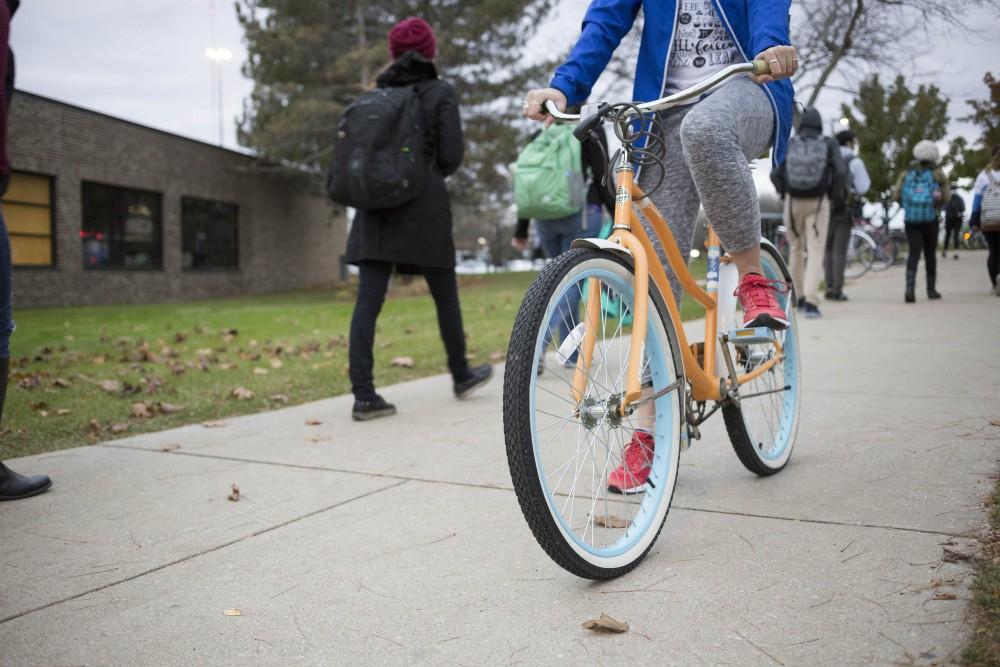New Grand Rapids campaign has lowered number of bicyclist-motorist crashes

GVL / Sara Carte Alison Farnsworth rides her bike near Kirkhof Center on Tuesday, Nov. 8, 2016.
Nov 10, 2016
The implementation of Grand Rapids’ largest ever bicycle safety campaign, coupled with the creation of local ordinances, has significantly reduced the number of bicyclist-motorist crashes and serious injuries this year, per a media release from the city of Grand Rapids.
According to the release, crashes resulting in fatalities or serious injuries “were reduced from 11 in 2015 to two in 2016 for the same five-month reporting period (May-September).” Additionally, the total number of crashes involving bicyclists “decreased by more than 40 percent from 2015 to 2016 for the same time frame.”
The ordinances partly responsible for this decrease in crashes include safety procedures for both bicyclists and motorists. Bicyclists are now required to have a front light and rear reflector for night riding, and motorists must keep at least five feet of space on their right when passing bicyclists on the left.
The awareness campaign accompanying these local ordinances, Driving Change, consisted of a publicity blitz from May 9 to Sept. 30 to educate the local community about the new safety regulations. During this period, information about the safety regulations was disseminated via billboards, television ads, radio ads in English and Spanish, social media, brochures and other platforms.
Police officers also took an active role in reaching out and educating the public.
“Our police officers even were equipped with information so that they could hand it to a cyclist or motorist that were violating the rules,” said Suzanne Schulz, Grand Rapids planning director. “(They) weren’t going to hand out tickets, even though they could with the new law. They were trying to educate the public before they did any enforcement, so they handed out information to the community.”
The Driving Change campaign was implemented to address a lack of knowledge about the new rules and to promote bicyclist safety.
“What we’ve found in talking to the public about bikes is that a lot of people were frustrated because they didn’t know the rules,” Schulz said. “They felt that there could be harmony, that people could get along on the road, if they knew what they were supposed to be doing.
“(We) can make all the laws in the world, but if people aren’t (aware) of the law, and they’re not aware of what they’re supposed to do, (the) effectiveness of it is not going to be as great.”
Driving Change, which is primarily funded through a federal grant, was conceived following thorough research of crash data in Grand Rapids.
“We did a lot of data mining before we even started the campaign because we wanted to understand what was behind it, what was causing crashes in Grand Rapids, and where can we make sure that they don’t happen again,” Schulz said. “We looked at crash data for multiple years, we did focus groups, we tried to really get a good feel for what causes this so that we could try to prevent it in the future.”
While the number of crashes and serious injurious involving bicyclists has dramatically decreased in 2016, the findings are not yet complete.
“The near-term, short findings were very impressive,” said Chris Zull, Grand Rapids traffic safety manager. “However, as an engineer, while this is good news, I wouldn’t say that it’s entirely complete. (You) usually have to find an impact over a certain amount of years, not just a certain amount of months.”
Still, Schulz thinks the data is promising and is excited by the results.
“(This) was the lowest crash rate we’ve had since we first started collecting the data (in 2004),” she said. “Given all of the deaths that you see, or the severe crashes that you see in the media involving bikes and cars, we really feel like this is going to make a difference.
“It also could have an impact at the statewide level as more communities want to adopt our approach, and they can even use the information that we’ve created to share it in their communities.”
With some more funding, a fresh wave of the Driving Change campaign will start again in the spring.
“There’s more cyclists out in the springtime, (and) we know that safety messages like this, if they’re heard multiple times, that it tends to stick better, that people will remember them,” Schulz said. “Being able to bring back the campaign for another year is really a big deal because then we really think that we’ll get traction and the awareness of safety from both cyclists and motorists.”
While the format of the spring campaign has yet to be determined, Zull said it will likely be similar to the public information distribution during the summer campaign. He hopes Driving Change will serve as a model for future endeavors in different communities, as well.
“At the end of the day, we’re going to end up with a playbook that other communities can pick up, learn about what we did and then do similar efforts for their communities,” Zull said. “(It) essentially becomes a model that other communities can use to deliver these same types of messages.”























